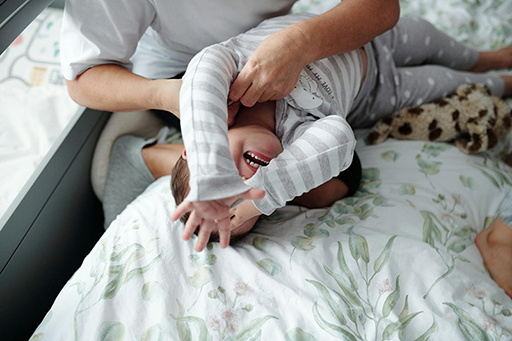3 Self-regulation
As babies and toddlers experience new and different situations they will have emotional responses, they might be surprised, shocked, pleased, frustrated and so on. In order to manage these feelings and responses they need to be able to self-regulate – this means they are able to control their impulses and either stop doing something or do something they are being asked to do. Developing self-regulation is an important part of a child’s wellbeing, and it also helps them to develop social and emotional skills that will be important as they progress through their learning (Bingham and Whitebread, 2012).
Babies are dependent on the adults around them to reassure them in order to develop self-regulation. When an adult is in tune with a baby’s needs, they are able to calmly soothe and distract them to show them that they are safe. These responses help them to learn to calm and distract themselves the next time they are in that situation. When toddlers experience strong emotions and feelings, they need help from adults to find their way back to calmness. This process of working alongside the baby or toddler to support them as they deal with situations is called ‘co-regulation’.
By the time toddlers reach their first birthday, they are usually starting to become more independent and want to do the things that they want to. This kind of behaviour tends to continue – you might have heard people talk about their child going through the ‘terrible twos’. This can be a tricky time, as the child often gets frustrated or angry and adults (parents and professionals) can find it challenging to deal with the situation, but it is a normal stage in the development of self-regulation.
To help a toddler develop their self-regulation when they are going through this period, it can be helpful to have a strategy to follow that provides a step-by-step approach to dealing with the situation. Here is an example of a strategy devised by Canale (2020) that can be used. Which step do you think you would find the most challenging and why?
| Step 1 | Consider: How can I be with my child during this tricky moment? |
| Step 2 | Calm yourself: Check whether you are feeling calm and in control of your own emotions. It’s important to calm yourself first so that you are able to respond to the child instead of reacting to them. |
| Step 3 | Calm the child: If the child is overwhelmed by big emotions they will need your help to calm down. Every child is unique and you need to use your knowledge of the child to identify what will help them. Some children like to be hugged and others may need a bit of space with you sitting nearby and using your voice to help them return to a state of calm. |
| Step 4 | Curiosity: Be curious about some of the underlying emotions or unmet needs that would explain why the child is behaving in this way. A useful acronym to remember is HALT. This stands for Hungry, Angry, Lonely, Tired. Are any of these needs unmet? Could this be the cause of their behaviour? |
| Step 5 | Connection: Join the dots for the child. Connect the underlying emotion or need to the behaviour you are seeing, e.g., ‘I think you are tired and that’s why you are throwing your toys…’ Connecting the child’s emotion to their behaviour helps them to feel understood and soothed, and will also help to develop their self-regulation skills as they grow. |
| Step 6 | Correction: This is where you provide a limit or boundary around the behaviour, e.g., ‘I think you are tired and that’s why you are throwing your toys, we need to put the toys away and have a rest’. If an age-appropriate consequence is needed, then natural consequences work best, e.g., ‘you hurt someone with the toy, the toy is going away’ or ‘you wouldn’t put your wellies on so there is not enough time to go outside’. |
| Step 7 | Connect (again): Once you’ve set down the limit and stuck to it, reconnect with the child, maybe with a hug or reading a story together. Don’t revisit the behaviour at a later time in the day – this re-connect time acts as the end of the episode. |

